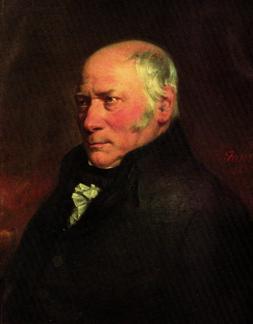
Geoscientist 17.5 May 2007
William Smith’s association with the Geological Society of London was fraught with difficulties. But when the Society awarded Smith the first ever Wollaston Medal in 1831, Smith was prepared to bury the hatchet. In a letter to his niece Anne Phillips, published here for the first time in full, Smith describes one of the most exciting days of his life. Nina Morgan* reports…
William Smith’s relationship with the newly founded Geological Society of London got off to a very bad start, for social, financial and scientific reasons. Class divisions were deep in the 19th Century and science was not the social leveller it is today. Smith belonged to a different social class from the 13 founders of the Geological Society. He probably could not have afforded either the 15s fee to attend the Society’s monthly dinner, nor the 10s 6d fee for non-attendance. Moreover, because he lived in London at that time, he was not eligible for honorary membership.
Although Smith seems to have accepted these facts of contemporary social life, he was disturbed that his practical work and geological insights were not taken seriously by some prominent members of the Geological Society, and continued to bear a grudge for many years. In 1816 he is reported to have complained that "the theory of geology was in the possession of one class of men, the practice in another".
His complaint had some justification. None of the three prominent authorities on practical or applied geology of the time, William Smith, John Farey and Robert Bakewell, was FGS. As Smith’s nephew, John Phillips records in his Memoirs of William Smith, LLD, (1884) Smith "was almost unnoticed [by the Geological Society], "except by visits from Mr Greenough, the president, Sir James Hall and a few other members, to examine his collections in Buckingham Street (March 1808)". They were, apparently, not impressed, and according to Smith expert Prof. Hugh Torrens, did not believe that Smith had discovered anything significant.
Nevertheless, 23 years later, the minutes of a special meeting of the Council of the Geological Society (11 January 1831) record that Council members present, including "Professor Sedgwick, President in the Chair; Mr Broderip, V.P. [Vice President], Mr Horner, VP., Dr Turner, Secy, Mr Murchison, Secy, Mr John Taylor, Treasr, Captn Vetch, Mr Whewell, Dr Roget, Mr De la Beche, Resolved unanimously that the first Wollaston Medal be given to Mr W. Smith, in consideration of his being a great original discoverer in English Geology, & especially for his having been the first /in this country to discover & to teach the identification of strata, & their succession, by means of their imbedded fossils."
Praise indeed
The Wollaston is the Geological Society’s highest award, presented to scientists whose outstanding work has had a significant influence. The Wollaston Medal and donation fund were established in 1828 by bequest of the mineralogist Dr William Hyde Wollaston, discoverer of palladium, in which metal it is now struck. In 1831 the award consisted of both a medal and a purse. The latter was presented to Smith during the afternoon session of the Society’s 1831 General Meeting, on Friday 18 February. Sedgwick presented a formal eulogy in praise of Smith - for which Smith himself provided much of the biographical background.
Afterwards, at the suggestion of William Henry Fitton, a great Smith supporter and the person Phillips believed was largely responsible for Smith's receiving the award in the first place, the eulogy was published in the Annual Report 1831. In his speech Sedgwick spoke of his personal debt to Smith and hailed him as ‘the Father of English Geology’. Smith was then presented with the purse of 20 guineas – or about £1400 today. He had to wait until 20 June 1832 to receive the Medal, as part of a ceremony in Oxford's Sheldonian Theatre, during the second annual meeting of the British Association for the Advancement of Science.
But Sedgwick’s ringing endorsement of William Smith almost certainly does not tell the whole story. Professor Gordon Herries Davies, the author of the Society's newly published Bicentenary history, Whatever is Under the Earth, suggests that the words ‘in this country’, inserted later, may be evidence that someone - most probably George Bellas Greenough - was attempting to minimise Smith’s achievement. Greenough, who is widely said to have "plagiarised" Smith’s 1815 map, was no Smith fan. But the insertion may have been added because of uncertainty about whether earlier work in Germany (by Abraham Gottlob Werner) pre-empted Smith’s discovery.
Smith did himself no favours by not publishing his own maps and sections promptly. There may have been practical reasons for the delay, but even Smith’s nephew, John Phillips, a great admirer and champion, admitted regretfully in his Memoirs of William Smith, LL.D., that Smith suffered from "...the habit of procrastination, which had resisted the ambition of scientific fame…".